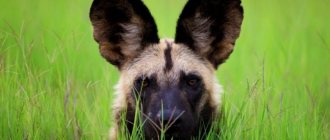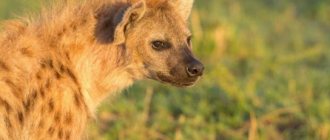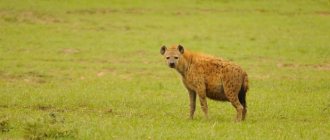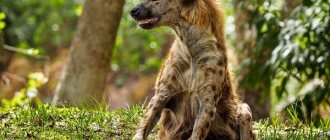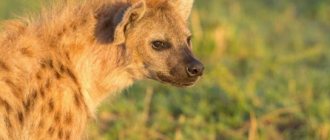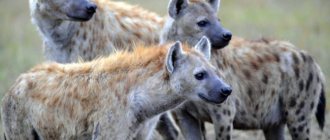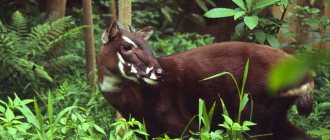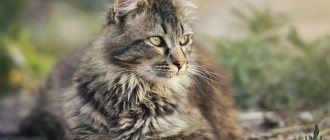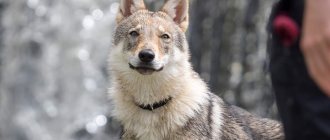Home page Wildlife Animal world
64 673 4.52 5
There is an opinion that friendly behavior can win a woman's heart much faster than a demonstration of strength. The male hyena understands this better than any other animal: since the females are the dominant ones in the pack, they get to decide who they want to be with - and they choose the best ones.
And the male, who is at a lower hierarchical level, can only wait - for some months, and for others years. If he is lucky and he can wait for the favor of the female, preferably the leader of the pack, then his status will increase, and he will become a leader among his own kind.
Therefore, when a female hyena passes by, he respectfully gives way to her, lowering his head as a sign of submission and pressing his ears, and if he notices that she is irritated, he quickly moves away.
These mythical animals
Rarely do any animals cause such hostility in people as hyenas - neither their appearance nor their wild behavior during the hunt inspires positive emotions in anyone. For a long time they were considered one of the most mysterious and little-studied creatures of this world, and therefore the most incredible rumors circulated about them, which, oddly enough, even the most prudent people believed.
For example, the indigenous people of Africa, looking at the persistence and enthusiasm with which these animals tore up graves, were convinced that hyenas were associated with evil spirits, and that they themselves were werewolves. When the Arabs killed this animal, they buried its head as deep as possible in the sand so that it would not return and take revenge for its murder.
Koalas are the original representatives of the living world of Australia174214.811
The ancient Greek philosopher Ovid believed (and substantiated his opinion so convincingly that he was able to convince many reasonable people) that an animal is a hermaphrodite and is capable of changing its gender. And his colleague Pliny argued that the spotted hyena, imitating the sound of a human voice, lures adults and children into the street, where it tears them apart.
Experiencing such mystical horror towards this wild animal, many agreed that medicines made from the internal organs of these creatures had miraculous powers: the liver healed the eyes, the cervical vertebra calmed the nervous system. But the brain was considered harmful: those who ate it went crazy.
What wonderful animals
Hyenas are members of a family of predatory mammals from the suborder Felidae. Interesting fact: if previously these animals were considered relatives of dogs, recently scientists came to the conclusion that such a classification was incorrect and added them to the family of cats and civets.
The hyena family includes species such as the aardwolf, striped, spotted and brown hyena. All these species live on the African continent, and the striped hyena also lives in Asia (they mainly live in steppes, semi-deserts and savannas, and the brown one can be seen near the coast).
Features and habitat of the hyena
Savannah belt is the name given to vast areas of African savannas covered with a carpet of grasses. This herbal kingdom stretches across the entire continent - from the south of the Sahara, then Niger, Mali, Sudan, Chad, also Tanzania and Kenya.
Savannas are comfortable for African animals; one of such interesting species is the wild hyena. Hyenas settle in open desert spaces, on the edges of forests near paths and roads. Vegetation in the savanna sometimes includes shrubs and rarely solitary trees.
The climate here is subequatorial. The year is divided into two seasons - dry and rainy. Africa looks interesting in pictures from space. From above you can clearly see the topography of this continent - most of it is occupied by deserts and evergreen rain forests. And in the center, a savannah stretches wide, full of free wind, grasses and rare lonely trees.
Scientists have established that the African savanna was formed about seven million years ago, this is proof that the savanna is a young zonal type. The life of plants and animals in savannas is directly dependent on the weather of these places.
Appearance
Externally, hyenas look like scary mongrel dogs with a short thick head and a pointed muzzle. The jaws of these animals are capable of creating the strongest pressure among all mammals - 70 kg/cm2 (they are the only predators in the world that can crush large bones of almost all animals with their teeth, with the exception of elephants). The hyena's paws are crooked and short, with the hind legs being much shorter than the front ones, which gives the impression that the animal is crouching.
The spotted, brown, and striped hyena each have four toes, while the aardwolf has one more toe. The claws of hyenas are long and blunt - this allows them to easily dig holes and dig up corpses.
The lightest representative of this species is considered to be the aardwolf (it weighs about ten kilograms), the largest is the spotted hyena, whose weight exceeds eighty kilograms. The spotted hyena has short hair, while in other species it is coarse and long, while the hair on all types of hyenas on the neck and along the back forms a mane.
Hyenas differ from each other in color:
- The spotted hyena is covered with gray fur with brown spots;
- The striped hyena has light gray fur with black stripes and a dark muzzle;
- The aardwolf and brown hyena have a uniform brown color.
A shaggy tail indicates the social status of the animal: if it is raised up, the animal is a leader, if it is lowered, it is an outsider. Each animal has its own unique smell - for people it smells disgusting, but in the life of hyenas it means the same thing as speech for a person.
Voice
The language of hyenas is very diverse and they communicate with each other using sounds - first of all, this is the world-famous cry, which is the laughter of hyenas, which creates the impression that the animal is laughing extremely unpleasantly. In reality, these sounds are a mixture of howling, screaming, roaring and something like laughter.
Thus, these animals control the order of eating: the main female informs the whole world that she has finished eating, and therefore the next individual in the hierarchy can start eating - this helps pugnacious, warlike and dangerous animals maintain established relationships in the pack, and also avoid fights and conflicts.
Such laughter is characteristic only of the spotted hyena, but the brown hyena and striped hyena do not make such a sound at all. They produce growls, screams, grunts and a rough hoarse howl.
Lifestyle
Not all representatives of this family live in packs: the striped hyena and aardwolf prefer solitude. But spotted and brown hyenas form packs of five individuals or more, while a pack of spotted hyenas can sometimes be huge and consist of a hundred individuals.
There is a clear hierarchy among these animals - all lower-ranking individuals are completely subordinate to their superiors (the position is determined primarily by the rank of the mother of small hyenas at their birth and it is extremely difficult to change it later). Males always occupy a lower position, and the most experienced female is in charge.
Hierarchy of the pack
The herd of spotted hyenas (photos are given in the article) is characterized by a clear hierarchy. Their clans live in matriarchal conditions. Females dominate males and occupy a higher position in society. In addition, the flock also has additional divisions into levels. Adults are considered the main ones. They have the privilege of being the first to eat and rest at the very entrance to the lair. They are faced with the task of raising large offspring.
Females at a lower level of the hierarchy do not have such greater privileges. As for the males, they occupy the lowest place in the pack, but there is also a division between them. All males express incredible submissiveness to the opposite sex. To reproduce, males often join other flocks.
An interesting fact is that there are constant wars over habitat between clans of African spotted hyenas. Predators constantly patrol the boundaries of their possessions, marked by their feces. A flock can number from ten to 100 individuals.
Breeding offspring
For quite a long time, people believed that spotted hyenas were hermaphrodites, and were confident that they practiced homosexual mating and gave birth using a unique reproductive system.
In fact, male spotted hyenas are born males and remain males, and the same is true for females. True, it is quite difficult for people to distinguish representatives of this species from each other, since the genitals of females completely copy the genitals of males. And all because the clitoris of female hyenas of this species is quite large and often reaches 15 cm (the higher the position in the pack the female occupies, the larger it is), and the labia form a sac-like fold, similar to a scrotum.
Since the female does not have a vagina, she not only mates, but also gives birth through the clitoris. Reproduction is quite difficult, since this process is painful and complex; childbirth, especially the first, often lasts for hours, which is why half of the puppies die from suffocation, and the female herself often dies (according to statistics, about 10% of mothers die during childbirth).
Animal babies
Interestingly, the female chooses her own partner. This is always a male of high rank, often from another clan, thus these animals avoid inbreeding. Pregnancy lasts about one hundred days, and few cubs are born - from one to three.
The female hyena is a very caring mother: she sets up a den in advance (mostly for this purpose she digs a hole on her own or finds a suitable cave), and takes care of her brood for up to two years, feeding them with milk for almost twenty months. Milk is so nutritious that, if necessary, a hyena cub can go without any other food for about a week.
Babies are born covered with uniform hair, fully sighted, with fangs and incisors - and almost immediately begin to defend their place in the sun, rushing at their brother or sister with the aim of biting them to death. They often succeed; about a quarter of the babies die as soon as they appear in this world. After some time, the passion for killing passes, and the surviving cubs learn to exist with each other.
Nutrition
They say that in Africa there are no skeletons lying around - everything is eaten by hyenas, whose stomachs can hold about fifteen kilograms of food at a time. All representatives of this family, with the exception of the aardwolf, are omnivorous creatures: they are unpretentious in food and eat absolutely everything they can - mammals, birds, snakes, termites, fish, melon, watermelon. They have rightfully earned a reputation as scavengers, capable of completely gnawing a corpse.
It was recently discovered that, in addition to everything else, they are also excellent hunters, and they eat carrion for lack of better food. Apart from the brown hyena, which is the largest land creature, its diet consists mainly of carrion, and the striped hyena, like the jackal, likes to pick up garbage.
The aardwolf feeds mainly on termites of a certain species, Trinervitermes, sometimes on other insects and their larvae, which it collects on animal corpses (primarily carrion beetles), as well as arachnids. During the night, it is quite capable of eating up to 300 thousand termites, while the animal does not destroy termite mounds, but patiently waits for the insects to come to the surface.
Thanks to these insects, this representative of the hyena family is almost independent of water, since it receives liquid from their bodies. In addition to Trinervitermes, the aardwolf also feeds on other types of animal food - usually small rodents, birds and their eggs, and sometimes plants.
But the spotted hyena is considered one of the most formidable predators in Africa, since representatives of this species combine enormous speed (more than 50 km/h), powerful jaws, skillful collective actions (they usually hunt in pairs or even in a pack) and amazing audacity.
Interesting facts about raccoons174214.714
The spotted hyena eats its victims in a unique way, as do other representatives of this family. From the outside it looks extremely disgusting and nauseating, since before a meal they do not kill their victims, but despite their screams, they eat them alive (although this way the prey dies faster than by strangulation).
Enemies
The worst enemy of hyenas in the natural world is the lion. Despite the fact that there is an opinion that hyenas constantly chase a lion in order to eat up the remains of its prey, in fact, everything is exactly the opposite; the prey is taken away from the hyenas by larger predators.
Of course, if only one lioness tries to do this, the flock is able to drive her away, but if there are many lionesses, or we are talking about a male lion, they easily drive away the entire clan from the legally hunted prey, often killing hyenas and their babies. In turn, hyenas never take pity on an old, wounded or too young lion, and at the slightest chance they settle scores with him with a scream.
What do predators eat?
The main diet for carnivores is meat. For a long time, people believed that hyenas only scavenge, taking prey from other predators. But recent studies have proven that animals obtain 90% of all food on their own by hunting.
Hyenas are not particularly picky about their diet, so they do not disdain any meat that comes their way. They don’t care what they eat: it could be a rotten elephant carcass or a live antelope. Of course, most of their diet consists of ungulates. Since predators lead a school life, they all hunt together. This makes it easier for them to deal with the victim, although a hyena alone can also catch a small gazelle or antelope.
